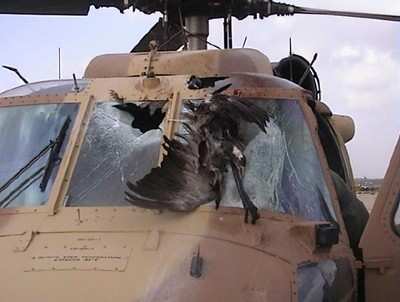System Scans Six Nautical Miles Out
In an effort to prevent aircraft bird strikes, the Air Force
Safety Center's Bird/Wildlife Aircraft Strike Hazard, or BASH,
chose Delaware's Dover Air Force Base as one of the test sites for
a radar that will help prevent bird strikes.

The radar is expected to be operational this month, and the
concept of operations will be developed over the next six to nine
months with coordination between flight safety, bird control, air
traffic control and base operations.
"The bird radar is a state of the art risk management tool that
is designed to identify biological targets (such as birds) in and
around the airfield," said Ron Merritt, president of DeTect Inc. in
Panama City, Fla., and former Air Force BASH Team chief.
Dover AFB recently received the 2006 Merlin XS2530 bird radar
from DeTect Inc., which scans both vertically and horizontally more
than six nautical miles and costs approximately $300,000.
The bird radar serves two purposes. It will collect data to help
compile information on bird movement patterns and will provide
real-time bird detection to locate large flocks.
"Due to the location of the base along the Mid-Atlantic coast,
(Dover AFB) is in the middle of a major migration route for birds
and is at the center of the wintering grounds for greater snow
geese and large numbers of migratory Canada geese, as well as many
gull species," said Dr. Karen Voltura, Dover AFB's Bird and
Wildlife Aircraft Strike Hazard chief of operations for Flyaway
Farm and Kennels Wildlife Management, the BASH contractor for Dover
AFB.
While Dover does not usually have a large number of bird
strikes, it has had several damaging strikes in past years.
"Currently, we average about 25 strikes per year," Voltura said.
"During the last four years, the Dover BASH program has been able
to decrease bird strikes here by over 55 percent."
The bird radar is expected to reduce these Dover statistics even
more.
"The information collected (by the radar) will help the BASH
program refine the scheduling restrictions that are part of the
Dover BASH plan, and eventually it will allow the immediate
detection of birds that are a direct risk to aircraft flying in and
out of Dover Air Force Base," said Dr. Voltura.
 A Merlin radar
system at Dare County Bombing Range, NC has almost completely
eliminated serious bird strikes, Merritt said.
A Merlin radar
system at Dare County Bombing Range, NC has almost completely
eliminated serious bird strikes, Merritt said.
"The bird radar should dramatically improve understanding of how
birds use the landscape around Dover Air Force Base both in time
and space," he said. "The displays should allow the bird control
staff to more efficiently deploy control efforts as well as provide
air traffic controllers with real-time advisories for aircrew."
Such real-time detection enhances risk management, particularly
at night or foggy, low-visibility days when Airmen cannot visually
locate flocks entering flight paths.
The birds are displayed by the radar onto a radar screen as a
target track, which is displayed over a map. Other objects such as
trees, buildings or large, fast moving aircraft are rejected by the
radar software, leaving only the targets of interest on the
display, said Mr. Merritt.
The radar is located on the flightline here, and the radar
picture it provides can be displayed on any computer with Internet
access. Eventually, the goal is for air traffic control to observe
the presentation and pass bird location information to aircrews via
radio communications.
(Aero-News salutes Staff Sgt. James Wilkinson, 436th Airlift
Wing Public Affairs. Some information in this article is courtesy
of Pacific Air Forces News Service and the Air Force Safety
Center.)
 ANN's Daily Aero-Linx (04.16.24)
ANN's Daily Aero-Linx (04.16.24) Aero-News: Quote of the Day (04.16.24)
Aero-News: Quote of the Day (04.16.24) Airborne 04.10.24: SnF24!, A50 Heritage Reveal, HeliCycle!, Montaer MC-01
Airborne 04.10.24: SnF24!, A50 Heritage Reveal, HeliCycle!, Montaer MC-01 Airborne 04.12.24: SnF24!, G100UL Is Here, Holy Micro, Plane Tags
Airborne 04.12.24: SnF24!, G100UL Is Here, Holy Micro, Plane Tags Airborne-Flight Training 04.17.24: Feds Need Controllers, Spirit Delay, Redbird
Airborne-Flight Training 04.17.24: Feds Need Controllers, Spirit Delay, Redbird




